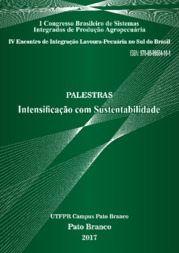Avanços técnico-científicos em SIPA no subtrópico brasileiro.
Avanços técnico-científicos em SIPA no subtrópico brasileiro.
Author(s): MORAES, A. de; PELISSARI, A.; CARVALHO, P. C. de; ANGHINONI, I.; LUSTOSA, S. B. C. L.; BALBINOT JUNIOR, A. A.; LANG, C. R.; ASSMANN, T. S.; ASSMANN, T. S.; ASSMANN, A.; PIVA, J. T.; SCHUSTER, M. Z.; KUNRATH, T. R.; MARTINS, A. P.
Summary: RESUMO: Este capítulo procura contar a história da pesquisa em Sistemas Integrados de Produção Agropecuária (SIPA) no subtrópico brasileiro, abordada desde a origem, até os mais recentes trabalhos científicos, as instituições e grupos de pesquisadores envolvidos. Estão descritos os protocolos de pesquisa em SIPA, considerados como de longa duração, além da evolução no conhecimento dos principais indicadores, que podem ajudar no entendimento do intricado processo das relações solo-planta-animal-atmosfera. Os Grupos de Pesquisa registrados no CNPq atuando em Integração Lavoura-Pecuária no Sul do País são: GPILP e GPPIA da UFPR que passaram a atuar sob a denominação de Núcleo de Inovação Tecnológica em Agropecuária (NITA), o GPSIPA-UFRGS, que junto com o NITA constituíram a Aliança SIPA, o GISPA-UTFPR e o grupo de pesquisa SIPA-UFSC. A atuação das instituições de ensino culminou em um total de 141 teses e dissertações defendidas em SIPA. Em decorrência disto, constatou-se um aumento exponencial no número de artigos publicados em revistas indexadas ao longo dos últimos 23 anos. Os principais indicadores avaliados tiveram por objetivo entender o impacto da transformação da cobertura vegetal no inverno, em área de pastagem, avaliando o efeito do pastejo sobre os sistemas agrícolas, na medida em que boa parte das relações soloplanta-animal-atmosfera, é mediada pelo efeito dos animais no sistema Os novos desafios para a pesquisa comtemplam à busca de respostas para a seguinte pergunta: Quais são os processos emergentes envolvidos nas diferentes rotas dos fluxos de energia e massa na interface solo-planta-animalatmosfera, que contribuem para o aumento da eficiência do sistema ABSTRACT: This chapter tries to tell the history of the research in Integrated Crop Livestock Systems (ICLS) in the Brazilian subtropics, from the origin, to the most recent scientific works, the institutions and groups of researchers involved. The longterm SIPA research protocols, as well as the evolution in the knowledge of the main indicators, which can help in understanding the intricate process of soil-plant-animalatmosphere relationships, are described. The research groups registered with the CNPq working on ICLS in the South of the Country are: GPILP and GPPIA of UFPR, which became known as the Nucleus of Technological Innovation in Agriculture (NITA), GPSIPA-UFRGS, which together with the NITA formed the ICLS Alliance, the GISPA-UTFPR and the SIPA-UFSC research group. The performance of educational institutions culminated in a total of 141 theses and dissertations defended in ICLS. Because of this, there was an exponential increase in the number of articles published in indexed journals over the last 23 years. The main indicators evaluated were aimed at understanding the impact of the replacement of the winter cover crop by pasture. It was, mainly, evaluated the effect of grazing on the agricultural systems, since much of the soil-plant-animal-atmosphere relationships are mediated by the effect of the animals on the system. The new research challenges contemplate the search for answers to the following question: "What are the emerging processes involved in the different routes of energy and mass fluxes at the soil-plant-animal-atmosphere interface, which contribute to increasing the efficiency of the system? "
Publication year: 2017
Types of publication: Book sections
Unit: Embrapa Soybean
Keywords: Produção agropecuária, Sistemas integrado
Observation
Some of Embrapa's publications are published as ePub files. To read them, use or download one of the following free software options to your computer or mobile device. Android: Google Play Books; IOS: iBooks; Windows and Linux: Calibre.
Access other publications
Access the Agricultural Research Database (BDPA) to consult Embrapa's full library collection and records.
Visit Embrapa Bookstore to purchase books and other publications sold by Embrapa.

